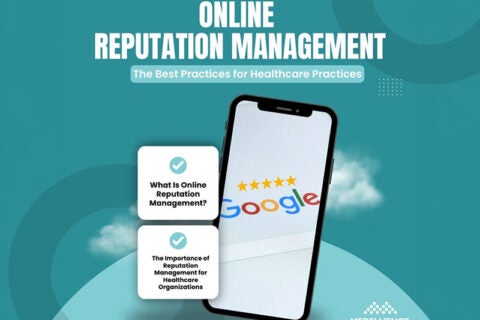Understanding Healthcare Marketing Analytics: What Metrics Matter Most
Most private practices aren’t short on skill, they’re short on clarity. They launch websites, post content, maybe run a few ads, and then cross their fingers. But without a solid grip on what’s actually working (and what’s just noise), even the best marketing efforts end up wasted.
In 2025, understanding your healthcare marketing analytics isn’t a luxury; it’s how you stop throwing budget into a black hole and start connecting with the right patients at the right time. This isn’t about chasing pageviews or social likes. It’s about tracking real-world impact: how many people found your message, resonated with it, and followed through.
Below, Medfluence Advisors will break down the metrics that actually move the needle and how to make them work for your practice’s long-term growth.

Quick Summary:
- Traffic means nothing without conversions. Pageviews and clicks don’t pay the bills—booked appointments do. Focus on attracting local, high-intent visitors who are more likely to take action.
- Track the numbers that matter: Conversion Rate, Cost per Acquisition (CPA), and Patient Lifetime Value (LTV). These metrics tell you whether your content is bringing in the right patients and if your investment is actually paying off.
- Use simple tools to trace what works. Google Analytics 4, UTM links, a basic CRM, and call tracking can give you all the insight you need—no data team required.
- Lead quality always beats quantity. Ten engaged leads who book consultations are far more valuable than a thousand casual browsers. Metrics like time on page and scroll depth help identify real interest.
- Stop chasing short-term wins. Healthcare content builds momentum over time. Measure performance quarterly and double down on what leads to conversions—not just what gets quick clicks.
Why “More Traffic” Isn’t the Goal
Getting a spike in website visits feels good, but if no one’s booking, it doesn’t mean much. In fact, the average website conversion rate in healthcare is only around 3.2%, and that drops even lower when traffic isn’t targeted.
Many practices create content that answers broad questions—“Is it a sinus infection or allergies?”—and while that might pull in thousands of views, it rarely attracts readers who are ready to act. Small practices, especially, can’t afford to chase vanity metrics like pageviews or bounce rate without tying them to real outcomes.
A post that gets 300 highly relevant visits from local patients actively searching for “balloon sinuplasty near me” is far more valuable than one that gets 5,000 hits from out-of-state students writing a research paper. Bottom line: if content isn’t helping move someone closer to scheduling, it’s just expensive noise.
The Metrics That Actually Point to Growth
Content marketing for medical practices should revolve around three core metrics—conversion rate, cost per acquisition (CPA), and patient lifetime value (LTV)—because these are the numbers that directly impact your bottom line.
- Conversion Rate: This tells you what percentage of your visitors take a meaningful action. If your landing page gets 500 views and 25 people schedule a consult, that’s a 5% conversion rate. For healthcare, that’s above average—and worth keeping. If you’re seeing less than 1%, something’s off with the messaging, design, or offer.
- Cost per Acquisition (CPA): This is your all-in cost to land one new patient. If you spend $1,500/month on content and it brings in 6 booked appointments, your CPA is $250. The key is knowing how that compares to the revenue generated by those visits. Which brings us to…
- Patient Lifetime Value (LTV): Many practices only look at the first consult, but a patient might return for multiple procedures or refer friends and family. If balloon sinuplasty brings in $4,000 and that patient sticks around for allergy treatment later, their LTV could double. Understanding this helps justify spending more upfront to get high-intent leads.
If your content strategy isn’t built around these metrics, you’re flying blind. Good content should feel helpful to the reader—but it should work just as hard for your practice behind the scenes.
How to Track What’s Working (Without Needing a Data Team)
You don’t need a full-time analyst to figure out which content is bringing in patients—you just need a few simple tools and a clear plan. Start with UTM tracking: these are little tags you add to links in your emails, ads, or social posts so you can see exactly where leads are coming from. Tools like Google Analytics or even basic CRM dashboards (like HubSpot or Pipedrive) can then tell you which blog post, ad, or email actually led to a phone call or appointment.
But here’s the catch—“last-click” attribution (which gives all the credit to the final thing someone clicked before booking) doesn’t reflect how patients really behave. Healthcare journeys are long and messy. A person might read a blog post on balloon sinuplasty, watch a doctor explainer video a week later, then finally book after getting a follow-up email. If you’re only looking at the last click, you’ll miss the bigger picture and cut off content that’s doing the slow, steady work of building trust.
What you actually need:
- Google Analytics 4 with UTM-tagged links
- A CRM that tracks where leads come from and when they convert
- Call tracking (like CallRail) if you rely on phone consults
What you can skip:
- Complicated attribution models
- Heatmaps (unless you’re redesigning your site)
- Vanity dashboards with 50 metrics that don’t lead to action
Keep it simple, track real behavior, and always tie content back to outcomes—like booked appointments, not just traffic or clicks.
Lead Quality Over Lead Quantity
Most private practices don’t need a flood of leads—they need the right ones. Ten people who are ready to book a consultation are more valuable than 1,000 people who clicked because of a catchy headline but had zero intent to follow through. In fact, chasing volume often backfires: your team wastes time on unqualified calls, and your marketing ROI tanks.
To spot real intent, look beyond surface-level clicks. Pay attention to how people interact with your content:
- Time on page tells you if they’re actually reading. Two minutes or more usually means they’re engaged.
- Scroll depth shows whether they’re making it to your call-to-action or bailing halfway.
- Bounce rate is helpful in context. A high bounce rate on a blog post might be fine—if it links directly to a booking form and users click through. If they’re bouncing without action, that’s a red flag.
You want readers who stick around, click through to your services, and ask informed questions. That’s how you know your content is attracting people who already feel like they’ve found the right place—not just people looking for general advice.
Where Most Practices Get Analytics Wrong
A lot of private practices either overthink their data or ignore it until they’re six months into a marketing campaign with no idea what worked. The biggest issue? Measuring the wrong things and reacting too quickly. It’s easy to get stuck in a loop of checking pageviews and bounce rates, but if you’re not tying those numbers to actual patient actions, they don’t mean much.
One common trap is chasing month-over-month growth like it’s a stock ticker. Content—especially in healthcare—has a long shelf life. A blog post may flop the first few weeks and then start ranking in Google months later. If you’re killing content based on 30-day performance, you’re likely tossing out ideas that just needed time. Instead of asking, “Did this work right now?” shift to: “Is this still gaining traction over the quarter? Is it part of a conversion path that brings in warm leads?”
Another mistake is using data in a vacuum—looking at bounce rate or session duration without asking what that behavior means in context. A blog might have a high bounce rate because it answered a question clearly and linked directly to a phone number or booking form. That’s a win, not a failure. But if people are spending 20 seconds on a services page and leaving, that’s a different story.
To fix this, set up a basic but meaningful system:
- Step 1: Tag your marketing channels with UTMs so you know where traffic is coming from.
- Step 2: In Google Analytics or your CRM, track how far that traffic goes—do they click “Book Now”? Do they return later?
- Step 3: Overlay qualitative input. Ask your front desk or intake team: What content are new patients referencing on calls? What questions do they already seem to have answered?
And most importantly, stop looking at everything monthly. Measure content performance quarterly so you can see which pieces build momentum over time—and where you’re getting diminishing returns.
Turning Insights into Action
It’s not enough to just gather analytics—you have to use those insights to shape your strategy. The first place to apply data is your topic clusters. If content related to nasal polyps drives conversions but deviated septum articles don’t, you know where to invest your next effort. You can also use keyword performance data to build new content around related questions patients are actually Googling.
Here’s how to turn raw data into a repeatable system that drives real marketing decisions:
- Cluster your content by condition, service, or patient concern. For example, a “Balloon Sinuplasty” cluster might include FAQs, recovery timelines, patient testimonials, and insurance info.
- Measure which clusters lead to booked consults—not just which get traffic. Do patients who read about insurance and prep instructions end up converting more often? If yes, that’s your signal to create more bottom-of-funnel content.
- Decide when to tweak and when to walk away. If a piece is getting traffic but not converting, try updating the CTA, rewriting the intro to match patient concerns, or improving internal links. But if three blog posts in a row on a topic get ignored, stop wasting time there.
Finally, treat this like a cycle—not a one-time audit. Build time each quarter to review, adjust, and plan your next wave of content based on what’s actually working. You don’t need a massive content team or fancy dashboards to do this—you just need consistency, clarity on what “working” means, and the discipline to act on it.
What Success Actually Looks Like
Success in content marketing isn’t about going viral or tripling traffic overnight. For growing practices, it’s about attracting the right patients, earning their trust before they ever walk through the door, and building a content system that keeps working long after you hit “publish.” That means setting realistic benchmarks and understanding what kind of results you should expect in the short and long term.
- In the first 90 days, most of your wins will be foundational. You’re identifying your highest-value patients, creating topic clusters around their most pressing concerns, and building out landing pages or blog content that speaks to their pain points. You may see modest traffic increases and a few consults come directly from your efforts, especially if you’ve combined your content with a strong local SEO push or email outreach.
- By month 6, your content starts to mature. Blog posts begin ranking for longer-tail searches. Videos and FAQs gain traction in voice search or on YouTube. You’ll notice more inquiries that reference a specific piece of content, more patients showing up informed, and a clearer idea of what’s converting. At this stage, patterns emerge—you’ll see which topics lead to real consults and which ones don’t move the needle.
- In months 9 to 12, content becomes an asset. Your highest-performing posts act like digital sales reps: pulling in new patients, answering objections, and shortening your sales cycle. You’ll likely be able to attribute specific consults and procedures to specific pages, videos, or email sequences. That’s when the ROI gets real—not in traffic spikes, but in procedures booked and patient outcomes improved.
Content marketing works, but it’s a slow burn. The goal isn’t just eyeballs—it’s trust, authority, and predictability. That’s what gets the right patients in your waiting room and gives your team the confidence to grow without chasing every new marketing fad.
What You Measure Shapes What You Build
At the end of the day, most private practices don’t need more data, you need better questions. The point isn’t to obsess over dashboards. It’s to understand what content moves someone from curious to committed, from reader to patient. That kind of clarity doesn’t come from guesswork or gut feelings. It comes from tracking the right stuff, watching for patterns, and giving your content room to grow.
And yes, it takes patience. Month three might feel slow. But by month twelve, the right strategy starts compounding—your content brings in warmer leads, your team spends less time on cold calls, and your calendar fills up with people who already trust you.
If you’re trying to make sense of your numbers or just want to stop feeling like you’re throwing spaghetti at the wall, we’re here. Medfluence Advisors is here to help practices build a system that actually works. Not overnight. But over time, with clarity.
Curious if what you’re doing is working? Let’s take a look together. No pitch. No pressure. Just answers.


